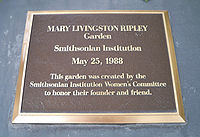- Sidney Dillon Ripley
-
Sidney Dillon Ripley (September 20, 1913 – March 12, 2001) was an American ornithologist and wildlife conservationist. He served as Secretary of the Smithsonian Institution from 1964-1984.
Contents
Biography
Ripley was born in New York City and studied at St. Paul's School in New Hampshire. In 1936 he graduated with a Bachelor of Arts (B.A.) from Yale University. His great-grandfather, Sidney Dillon, was President of the Union Pacific Railroad.
A visit to India at age 13, along with his sister, included a walking tour into Ladakh and western Tibet. This led to his lifelong interest in the ornithology of India. He decided that birds were more interesting than law, and he began studying zoology at Columbia University. He later obtained a Ph.D. in zoology from Harvard in 1943.
During World War II, he joined service in the Office of Strategic Services, the predecessor of the Central Intelligence Agency, and was in charge of American intelligence services in Southeast Asia. He trained many Indonesian spies, all of whom were killed during the Second World War.[1] An article in the August 26, 1950 New Yorker said that Ripley reversed the usual pattern, where spies posed as ornithologists in order to gain access to sensitive areas, and instead used his position as an intelligence officer to go birding in restricted areas. The government of Thailand gave him a national award for his support of the Thai underground during the war.[1] While serving in the OSS he met his future wife Mary Livingston and her roommate Julia Child.
Ripley entered Nepal in 1947. He pretended to be a close confidante of Jawaharlal Nehru and the Nepal government which was eager to maintain diplomatic ties with its newly independent neighbour had allowed him to collect bird specimens. Nehru came to hear of the New Yorker article and the work of Salim Ali was impeded as Ripley, the coauthor of his planned book, had become "public enemy number one" of India. Salim Ali came to hear of Nehru's displeasure through Horace Alexander and the matter was forgotten. The OSS past however ensured that scientists working in India were suspected to be CIA agents. David Challinor, a former Smithsonian administrator, noted that there were many CIA agents in India, with some posing as scientists. He noted that the Smithsonian sent a scholar to India for anthropological research who unknown to them was interviewing Tibetan refugees from Chinese controlled Tibet but went on to say that there was no evidence that Ripley worked for the CIA after he left the OSS in 1945.[1]
He joined the AOU in 1938, became an Elective Member in 1942, and a fellow in 1951. After the war he taught at Yale and was a Fulbright fellow in 1950 and a Guggenheim fellow in 1954. He became a full professor and director of the Peabody Museum of Natural History. Ripley served for many years on the board of the World Wildlife Fund in the U.S., and was the third president of the International Council for Bird Preservation (ICBP, now BirdLife International).
He served as Secretary of the Smithsonian Institution from 1964-1984. The S. Dillon Ripley Center was named in his honor. In 1967, he helped found the Smithsonian Folklife Festival, and in 1970, he helped found Smithsonian magazine. In 1985 he was awarded the Presidential Medal of Freedom, the highest civilian award. He was awarded honorary degrees from 15 colleges and universities, including Brown, Yale, Johns Hopkins, Harvard, and Cambridge in the U.K..
Legacy
He had intended to produce a definitive guide to the birds of South Asia, but became too ill to play an active part in its realisation. However, the eventual authors, his assistant, Pamela C. Rasmussen, and artist John C. Anderton, named the final two-volume guide as Birds of South Asia. The Ripley Guide in his honour.
A garden between the Hirshhorn Museum and Sculpture Garden and the Arts and Industries Building was dedicated in 1988 to his wife, Mary Livingston Ripley.
Selected writings
- The Land and Wildlife of Tropical Asia (1964; Series: LIFE Nature Library)
- Rails of the World - A Monograph of the Family Rallidae (1977)
- Birds of Bhutan, with Salim Ali and Biswamoy Biswas
- Handbook of the Birds of India and Pakistan, with Salim Ali (10 volumes)
Notes
References
- S.A. Hussain (2002) "Sidney Dillon Ripley II 1913-2001." Ibis 144(3), 550–550 doi:10.1046/j.1474-919X.2002.00090_1.x
External links
- Smithsonian biography and obituary
- Sidney Dillon Ripley obituary
- NY Times obituary
- Livingston Ripley Waterfowl Conservancy
Secretaries of the Smithsonian Institution Joseph Henry (1846) · Spencer Fullerton Baird (1878) · Samuel Pierpont Langley (1887) · Charles Doolittle Walcott (1907) · Charles Greeley Abbot (1928) · Alexander Wetmore (1944) · Leonard Carmichael (1953) · Sidney Dillon Ripley (1964) · Robert McCormick Adams, Jr. (1984) · Ira Michael Heyman (1994) · Lawrence M. Small (2000) · Cristián Samper (2007) · G. Wayne Clough (2008)
Categories:- 1913 births
- 2001 deaths
- Yale University alumni
- Columbia University alumni
- Harvard University alumni
- American Episcopalians
- American ornithologists
- Secretaries of the Smithsonian Institution
- People of the Office of Strategic Services
- Guggenheim Fellows
Wikimedia Foundation. 2010.


